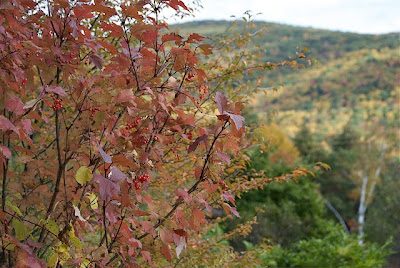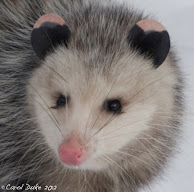In my last post I introduced my berry bountiful Viburnums and wish to elaborate a bit more on these valuable shrubs. The fuzzy one here in the background is the same doublefile Viburnum plicatum tomentosum from the previous posting. It reaches about eight feet towards the sky and stretches over into other shrubs of Viburnums and a Lilac creating a dense leafy habitat for birds. I show this one again to point out the contrast to another doublefile Viburnum of a different growth habit in the south upper garden area.
The facade or hedgerow of the upper garden has a few Viburnums planted along with Lilac topiaries, Honeysuckle and tree Wisteria to create a wall around the garden. It is also favored by some birds who love to nest within the thick canopies. This doublefile Viburnum is only about four feet tall and spreads out to eight feet.
Stepping inside the upper garden and looking out . . . the Viburnum does not block the beautiful view of Carey Hill and High Ridge. Her fluffy flowers are food for many insects and add contrasting beauty to the splendiferous spring green.
Midsummer displays another contrast and brings more bird food to the garden table.
Going further within the upper garden we find the delicate Viburnum sargentii 'Onondaga' growing along the eastern edge.
The lace cap flowers attract many bees, butterflies and other insects that birds consider light protein snacks.
Goldenrod blooms about the same time the berries ripen.
Bright red fruit and colorful fall foliage add to the beauty, interest and wildlife value of the garden . . . another example of Viburnums as prolific living bird feeders.
Viburnum carlesii also known as Koreanspice fills more than its possible six to eight feet height and spread. Its perfume can reach a person thirty feet away. It is a delightful shrub and feeds more than just my soul.
One can easily understand why the Goldfinches would consider these to be tiny crabapples! After learning to eat the larger and tougher fruit, these bright red morsels of buds must seem specially made for the Goldfinches sharp beaks. Alas! It becomes a battle between us, for I am just as keen that they learn the difference! Luckily they are quick learners.
For I love these tiny florets that spill sweetness into the garden air. Butterflies and bees benefit as well from my berating the bratty finches. Goldfinches are most enjoyable and welcome in the gardens, when they are well behaved.
Many birds then may freely enjoy the juicy clustered berries that cover the Viburnum in summer.
Another great bird feeder and a native Viburnum, as well, is American cranberry bush or Highbush-cranberry. It is scientifically known as Viburnum opulus var. americanum. I have pruned this shrub over the years into a weeping-like form, to keep it from growing too tall thereby blocking the view from the studio. The lace cap flowers are visited by bees and butterflies.
Later glossy fruits tempt birds and chipmunks.
Winters past I have seen six or more Bluebirds, Robins and Cedar Waxwings all together on this one shrub. With candy like this . . . I can understand why.
Now for a reality check and a harsh contrast to the warmer days represented above. These time consuming bird review posts have been a wonderful escape from our very cold winter landscape. This photo of the Crabapple along the edge of the orchard was taken yesterday a few minutes after a very sweet visit from a pair of Bluebirds. The Crabapple is closer than it appears in this image.
I mentioned recently that I had noticed a Bluebird coming up to the barn studio window trying to catch a large black fly. In the winter for some reason flies hatch out inside and naturally fly towards the light. I opened the door to shoo a few flies out and was pleased . . . even elated . . . to see the Bluebird immediately come to the snow beneath the barn to pick up her fresh meat.
Now the Bluebirds come up and wait for their snacks. This female even allowed me to open the door and take her portrait, when less than ten feet away. I did get some flies to exit right after this photo shoot. I never imagined I would be longing for more flies!
She was a bit curious about what I was doing . . . as the camera clicked I imagine . . . and seemed to be so trusting.
This photo of a male Bluebird was taken after he had flown down and back again once capturing a fly morsel.
I am amazed at how I was able to be so close to this felicitous fellow. I could not help but wonder . . . might he know me from another time.
When he was just a little tot! I can never be certain if there is a knowing or if it is the freezing temperatures causing the birds to throw off their usual cover of caution. The contrast is very welcome. I worry perhaps I should do more for them this year . . . mealy worms perhaps. Later yesterday . . . around four in the afternoon . . . I did see a few Bluebirds fly down to the nestbox behind the farmhouse and go inside. I assume to cuddle during the chilly overnight hours.
A flock of Cedar Waxwings were in the Crabapple orchard today but no sign of a Bluebird. The Cedar Waxwings also let me open the door to take a few photos. They too are usually very skittish. Perhaps the arctic cold gripping winter has altered their fear of me to more of an accepting . . . for now . . . nature.
In a land far away with mutual freezing temperatures and a love of gardening . . . Katarina hosts Blooming Friday. Be sure to visit her Roses and Stuff to see other contrasting thoughts and images from around the world.





















































































































































